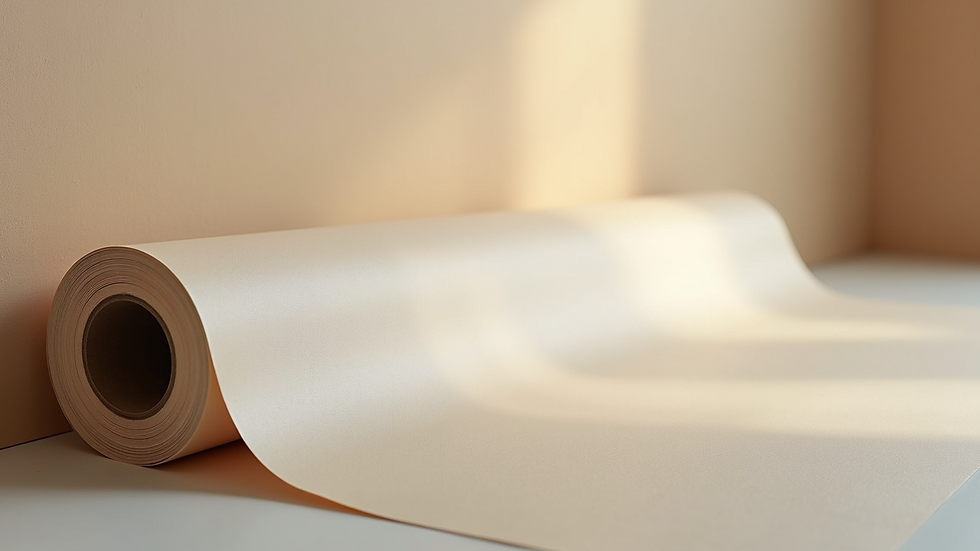The Importance of Installing Lining Paper Prior to Fine Wall Coverings
- Perla Paperhanging

- Jun 25
- 5 min read
Updated: Jul 1

When it comes to home decor, the walls play a critical role in defining the ambience of a space. One of the essential steps often overlooked before applying fine wall coverings, like expensive wallpapers, is the installation of lining paper. This extra step offers a range of benefits that can significantly enhance the overall quality of your wallpaper installation and the longevity of the wallpaper itself. In this blog post, we will explore the importance of installing lining paper prior to fine wall coverings, showcasing the difference it can make in achieving a flawless, durable finish.
Understanding Lining Paper
Lining paper is a type of wallpaper that is used as a base layer before applying finer wall coverings. It is particularly beneficial for wall surfaces that may have imperfections or varying textures. By creating a smoother surface, lining paper can help ensure that the final wallpaper adheres properly and looks visually appealing.
In addition, lining paper provides a better grip for porous pulp papers. These types of wallpapers require the lining paper to be railroaded and hung horizontally to lock in seams effectively. This process not only helps in achieving a seamless finish but also prevents any potential peeling or bubbling of the wallpaper over time.
The Benefits of Using Lining Paper
Installing lining paper comes with several key benefits, especially when dealing with luxurious wallpaper materials. Here are some of the most significant advantages:
A Smooth Surface for Wallpaper Application
One of the primary reasons to install lining paper is that it provides a smoother surface for the top layer of wallpaper. Even the slightest imperfections in your wall can become more pronounced once the wallpaper is applied. A lined wall ensures that these imperfections are hidden, resulting in a neater finish.
For instance, if you're applying silk wallpaper or clay-coated paper, the impact of underlying texture can become visible. Lining paper helps to mitigate this effect, allowing the true beauty of the wallpaper to shine through.

Enhancing the Durability of Wallpaper
When it comes to interior design, durability is key. High-quality wallpaper can be a significant investment, and lining paper serves as an insurance policy to enhance its longevity. It not only supports the wallpaper but also protects it from moisture and temperature changes, which can otherwise weaken the adhesive bond.
As a result, using lining paper can prevent issues such as bubbling, peeling, and fading. By investing just a bit of extra time during the application process, you are safeguarding your expensive wall coverings for the long term.
Better Adhesion and Seam Locking
Another compelling reason to use lining paper is that it helps with adhesion and seam locking. Many fine wallpapers require a specific installation method — such as being railroaded and hung horizontally. This technique locks in the seams properly, reducing the risk of lifting edges and creating a more polished look.
The added grip provided by lining paper is essential for porous pulp papers, which can absorb moisture from wallpaper paste. This characteristic can lead to expansion and contraction, resulting in seams that open up and degrade the overall appearance of the wallpaper. Lining paper helps counter this problem.
How to Install Lining Paper
While the benefits of lining paper are clear, it's essential to understand how to install it effectively for the best results. Here's a step-by-step guide to streamline the application process.
Step 1: Preparing the Wall
Before applying lining paper, ensure your walls are clean, dry, and free from any loose materials. If your walls have imperfections or holes, consider filling them with appropriate filler and sand the surface once dry.
Step 2: Measuring and Cutting
Measure your wall height accurately and cut the lining paper accordingly. It’s advisable to cut the lining paper slightly longer than the height of the wall to make adjustments easier during the installation.
Step 3: Applying Adhesive
Prepare the adhesive recommended for lining paper, as different types may require different preparation. Apply the adhesive to the wall, ensuring complete coverage without excess.
Step 4: Hanging the Lining Paper
Start from the top of the wall and work your way down. Align the lining paper vertically using a plumb line for precision. Smooth out any air bubbles using a damp cloth and ensure the edges are well adhered.

Step 5: Curing Time
Once the lining paper is hung, allow it to cure for 24 hours before applying the top layer of wallpaper. This waiting period is critical to ensure that the lining paper is fully adhered to the wall.
Frequently Asked Questions About Lining Paper
Is Lining Paper Necessary for All Wallpaper Types?
While lining paper is not strictly necessary for all wallpaper types, it is highly recommended for expensive and delicate wallpapers, such as clay-coated papers, silk paper, and British papers. The use of lining paper greatly enhances the appearance and durability of these wallpapers.
What Happens If You Skip Lining Paper?
Skipping lining paper can lead to a variety of issues, such as visible seams, wallpaper peeling, or bubbling over time. It increases the risk of dissatisfaction with the finished look and may necessitate a complete redo.
Can I Apply Lining Paper Myself?
Yes, with some basic tools and patience, many homeowners can install lining paper themselves. However, it is recommended to consult with professionals if you're unsure, especially with expensive materials.
Maximizing the Benefits of Lining Paper
To maximize the advantages of lining paper, consider the following tips:
Use high-quality lining paper to ensure the best results.
Take your time during the measuring and cutting process to avoid mistakes.
Ensure your wall surfaces are well-prepared for optimal adhesion.
Don’t rush the curing period; this time is crucial for a successful installation.
Final Thoughts
In the world of interior design, few things can enhance the beauty of your home like fine wallpaper. However, to achieve a truly flawless and durable finish, lining paper must be an integral part of the preparation process. While it might extend the installation timeline by a day, the advantages far outweigh this minor inconvenience. With better adhesion, increased durability, and an overall smoother finish, lining paper is an essential step for any luxury wallpaper project. By prioritizing this important phase, you ensure a classy, elegant, and lasting décor that reflects your taste and style.
Addressing these elements not only transforms a room but also affirms your commitment to quality and detail in your home design. So next time you consider wall coverings, remember the significance of lining paper and reap the benefits for years to come!
At Perla Paperhanging we install lining paper often and highly recommend for a flawlessly wallpapered room.
.png)




Comments